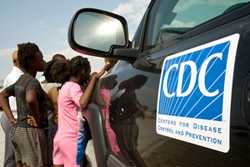CDC at Work: The Safe Water System

CDC responds to global public health needs (CDC Foundation)
Safe Water System (SWS) programs have operated in over 35 countries around the world. Through the combined efforts of public and private partnerships, a volume of products sufficient to treat over 137 billion liters of water (as of 2013) has been sold since 1998.
SWS programs foster behavior change and target the most vulnerable populations through linkages with antenatal care clinics, schools, the U.S. President’s Emergency Plan for AIDS Relief (PEPFAR) HIV/AIDS programs, community-based programs, and faith-based programs, among others.
CDC is actively engaged in research to identify optimal methods for household water treatment, and the ways in which these approaches can be scaled up and sustained until the goal of universal access to safe drinking water is achieved.
Learn more about:
Promoting Household Water Chlorination
Since the early 1990s, CDC helped develop the evidence base for household water chlorination and safe storage as a means for people who lack access to safe water sources to protect themselves from cholera and other waterborne diseases. This approach has since flourished, and today an estimated 67 million people chlorinate their household drinking water.
Many of these people obtain locally manufactured water chlorination products through self-sustaining programs that CDC helped establish. CDC has provided technical assistance in 25 countries through partnership with the U.S. Agency for International Development (USAID), Population Services International (PSI), CARE, Rotary International, and the private sector.
Developing Other Household Treatment Methods
CDC has conducted laboratory and field research on other methods of household water treatment including combined chlorination-flocculation and ceramic filtration. Through a Cooperative Research and Development Agreement with Procter & Gamble, CDC helped develop and refine P&G™, the combined coagulation-flocculation product produced by Procter & Gamble and used in many countries.
Studying a Variety of Settings and People
CDC water treatment products have been adopted for use in many different settings, targeting vulnerable populations in the developing world. These include PEPFAR-supported programs for persons with HIV/AIDS, antenatal care clinics, schools, and women’s groups. In addition, products that CDC has helped evaluate are routinely used by organizations responding to natural disasters around the world, such as tsunamis, earthquakes, and flooding.
CDC studies the burden of diarrheal and other waterborne diseases in different places and populations, looking specifically at the contribution made by different etiologic agents and at the costs and long-term sequelae in order to identify and advocate for evidence-based targeted solutions that are cost-effective.
CDC also examines the health benefits of proper use of water for hygiene, as well as preparation of foods and beverages, in order to reduce the risk of contamination.
- Page last reviewed: March 12, 2014
- Page last updated: May 2, 2014
- Content Source:


 ShareCompartir
ShareCompartir